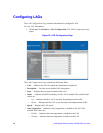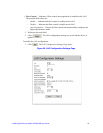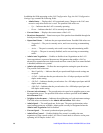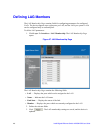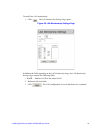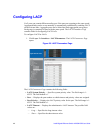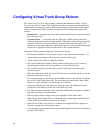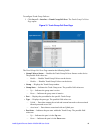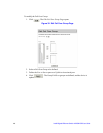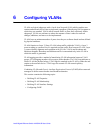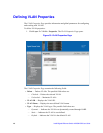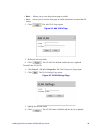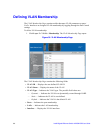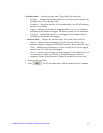44 Intel® Gigabit Ethernet Switch AXXSW1GB User Guide
Configuring Virtual Trunk Group Failover
The Trunk Group Fail Over Page enables a network administrator to define a Virtual
Trunk Group Failover feature. The Trunk Group Failover increases network stability by
ensuring that if a trunk group fails, a different trunk begins to forward the failed trunk’s
traffic. A Virtual Trunk Group Failover is comprised of user defined port groups that
include:
• Uplink Ports — Connects the switch and external network to the associated internal
ports and server NIC.
• Associated Ports — Associated with an Uplink port. Uplinks ports forward host
traffic associated ports to the external network. Although an associated port typically
connects to a Device. External switch ports can also be an Associated port. For
example, a server connected to an external switch port as well as to a dependent group
of ports on an Uplink port that forwards traffic to the external network.
Ensure the following when configuring Virtual Trunk Groups:
• The minimum number of Virtual Trunk Groups is one, whereas the maximum is 12.
• A port cannot be a member of more than one Virtual Trunk Group.
• Virtual Trunk Group Failover is globally enabled.
• The Virtual Trunk Group Failover feature cannot be defined on LAGs. However,
individual ports within a LAG can be added to a Virtual Trunk Group.
• One Virtual Trunk group can have one or more Uplink ports, and one or more
Associated ports.
• Only one Uplink port within the Virtual Trunk Group is required to go up in order for
all the associated ports to go up.
• The Associated ports are deactivated within 500ms from the time that the last Uplink
port in the Virtual Trunk group fails. The Associated ports reactivate within 500ms
whenever a single Uplink port within the group is restored.
• Before the administrator shuts downs an Associated port, the administrator must
exclude the Associated port from any Virtual Failover group.
• The Associated ports which have been shut down administratively cannot be added to
any failover group by the administrator.
• Failover groups can be configured any time regardless of the feature state.
• When Virtual Trunk Group Failover is disabled, all Associated ports disabled by the
Virtual Trunk Group Failover feature are re-enabled.
• When Virtual Trunk Group Failover is enabled, all configured failover groups are
scanned to update the Associated port status.
• A log message is generated and sent to the system log and stored when an Associated
port goes UP or Down.



